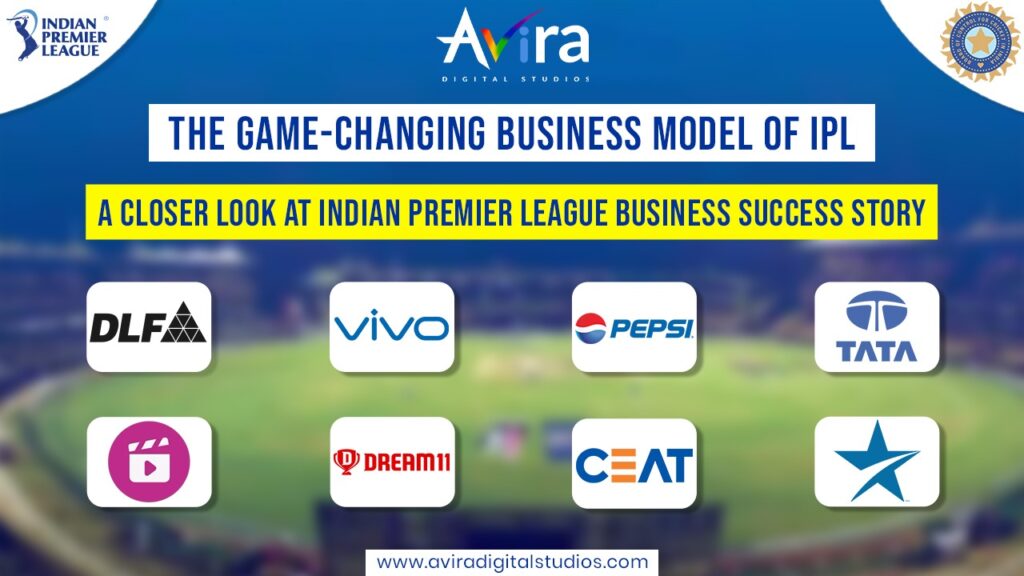The Indian Premier League (IPL) is a big cricket tournament in India that started in 2008. Avira Digital Studios is going to shed light on the IPL business model in India. It is the first famous T20 cricket league in the world where different teams play against each other including foreign players from all over the world. People love to watch these exciting IPL matches but It’s not just about cricket. There is also lots of fun and entertainment. IPL has become a big deal in cricket and lots of people get involved every day. BCCI, the organiser of the league makes a lot of money through it.

The IPL business model in India is centralised by the franchisee system where different teams are owned by various individuals or companies. They invest significant capital in player acquisition through auction. IPL franchisee owners also invest money in branding, marketing, and infrastructure to build a competitive team and try to build a strong base.IPL operates in a revenue-sharing model. Revenue streams of IPL include broadcasting rights, sponsoring deals, ticket sales, merchandise, and team endorsements. The combination of lucrative revenue streams and profit-sharing mechanisms has made the IPL one of the most financially successful sports leagues globally.
IPL Business Model in India: How Does BCCI Make Money with Franchisees :
1. Broadcasting Rights :
The major source of income is the broadcasting rights. It involves the rights to telecast and stream matches on various platforms across locations. It is completely a planned process.
The Board of Cricket Control in India(BCCI) breaks the rights into two parts. One is for television rights and another is for streaming platforms. Star Sports and Jio Cinema won the television and digital rights consecutively. The recent deal for 2023-2027 is $6.2 billion. BCCI shares 40-50% of it with franchisees. Intense competition benefits BCCI financially and pushes for innovation. Broadcasters introduce new features to improve viewer experience. The main objective of all activities is to attract more viewers and provide high-quality entertainment.
2. Franchise Fees: A Strategic Cash Injection for the BCCI :
BCCI earns a premium franchise fee when a franchisee participates for in the IPL. It provides an effective strategic move with long-term benefits. It also acts as an entry barrier. This premium fee ensures the participation of only serious and well-funded organizations.BCCI uses this amount to improve cricket infrastructure and overall development programs. It is not just a one-time fee, new franchisees introduce new ideas and increase the fan base in a region. It increases sponsorship amount and other long-term benefits.IPL started with 8 franchisees in 2008 but two new franchises from Lucknow and Gujrat were introduced recently which brings new fresh fan base from this location.
3. Sponsorship :
Every company wants to associate with IPL as it gives a lot of eyeball attention. The first title sponsor was DLF. After that, the sponsorship went to PEPSI, VIVO. Now current sponsorship is under the crown of TATA. The sponsorship amount is close to INR 670 cr. There are other sponsors along with the title sponsors those are official sponsors Dream11, CRED, Upstox, RuPay, official umpire partner Paytm, and Merchandising PlayR. BCCI earns more than INR 300 cr. apart from the main title sponsor. Now the question is why do these sponsors give a lot of money to showcase their name? Is it to increase the sales directly? No. It can’t be said that sponsorship would bring sales instantly but it is done because of recall value creation. For example during the strategic timeout, the CEAT name would be mentioned on the screen for more than 1 minute. So if you are a regular viewer of IPL, you keep the CEAT name in mind. In the future, if you want tires then you can choose CEAT. This is one of the reasons to select IPL as a sponsorship platform. So it is very easy for BCCI to earn money as well.
4. Advertising :
As you have understood broadcasters pay huge money for the rights. Now how to recover this money? Advertising on their platform is the way forward. Companies who are unable to make a sponsorship deal can get a lot of view of the audience through advertisement. In 2024, Jio Cinema is not taking any charges from the viewer to show IPL matches but it is recovering its invested money by allowing different brands to run their advertisements on the platform during break time.
5. Ticket Sales :
Franchisee owners earn from the ticket sales in the stadium. The revenue completely depends on the no. of seats available in the stadium and the economic condition of the population. For example in Kolkata, the home venue for Kolkata Knight Riders is Eden Gardens which has a capacity of more than 60k and the lowest ticket price is INR 500. Each venue gets a minimum of 9 matches. So this is a strong backbone of revenue generation which structured the IPL business model in India.
6. Merchandise and Fan Engagement :
When you analyze the IPL case study, another income stream of franchisees is merchandise sales. Franchisees sell their jerseys, caps, and various other accessories which contribute additional earnings. The popularity of franchisees affects the revenue from merchandise.
In conclusion, it can be said, that the IPL business model epitomizes innovation, excitement, and profitability in the realm of sports entertainment.
If you want to know the latest updates on design, development, and marketing, follow the blogs of Avira Digital Studios
Connect With Us :

Design, Development, Marketing Company Kolkata- Avira Digital Studios :
13, Barrackpore Trunk Road, Netaji Colony, Nainan Para, near Baranagar, Kolkata, West Bengal 700036

